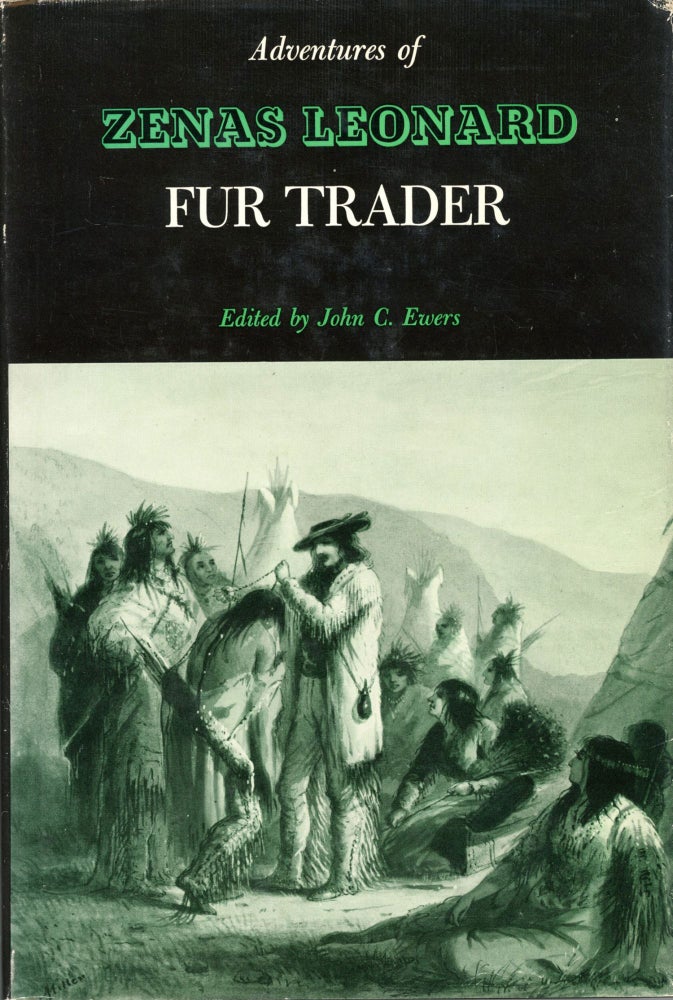Adventures of Zenas Leonard fur trader. Edited by John C. Ewers. Norman: University of Oklahoma Press, [1959]. 22.8x15 cm (octavo), pp. [i-vi] vii-xxv [xxvi] xxvii-xxix [xxx-xxxii] xxxiii [xxxiv] xxxv [xxxvi] [1-2] 3-172, 16 illustrations on 8 inserted plates, 1 double-page map, original black cloth, spine panel lettered in white and green, top edge stained green. Fifth edition. This edition includes an 18-page introduction, notes, and 3-page bibliography by Ewers. THE NARRATIVE OF ZENAS LEONARD (1809–1857) is the principal source of firsthand information concerning the Walker expedition of 1833, the first party to use the Humboldt River route to California and to make an east to west crossing of the Sierra Nevada. On his twenty–first birthday Leonard announced his intention of striking out on his own and left his father's farm near Clearfield, Pennsylvania. He spent several months in Pittsburgh working for an uncle. Determined to be a trapper in the Far West, he went to St. Louis, and in April 1831, as a clerk, left for the mountains with the party of Gantt and Blackwell. The trading firm dissolved but Leonard remained in the Rockies as a free trapper. At the Green River rendezvous of 1833 he met Bonneville and was engaged as a member of Joseph Reddeford Walker's California expedition. This party crossed the Utah and Nevada deserts, passed over the Sierra Nevada, and reached the Pacific Coast in November 1833. Leonard's account of the Sierra Nevada crossing indicates that members of the Walker party were the first non–Indian men to look into the Yosemite Valley and to see a grove of giant sequoia on the western slope of the range. The Walker party left California by a more southerly route and, passing through what is now called Walker Pass, the expedition reached Bonneville's camp on Bear River in July 1834. Leonard remained in association with Bonneville until the summer of 1835, returning to Independence with him in August of 1835, and reaching his old home in the fall of 1835. It was in Clearfield that he wrote the account of his travels which was published in part in a Clearfield newspaper, PIONEER & BANNER. AND DEMOCRATIC FREE PRESS, in 1835 and 1836. "Though, owing to the theft or loss of a part of his journal, Leonard is sometimes faulty as to incident and oftener faulty as to dates, his work is highly valued, and as a contemporary depiction of the daily life of the trapper is surpassed only by the Journal ... 1834–1843 (1914) of Osborne Russell" (W. J. Ghent, "Zenas Leonard," Dictionary of American Biography, ed. Dumas Malone [New York: Charles Scribner's Sons, 1933], VI, p. 180). "Leonard and Bonneville wrote the principal accounts of the Walker expedition to California. Bonneville's version, however, differs considerably from Leonard's account in that Bonneville did not accompany the party and also because he was incensed by the expedition's failure to find and bring back quantities of furs" (Henry R. Wagner and Charles L. Camp, The Plains & the Rockies: A Critical Bibliography of Exploration, Adventure and Travel in the American West 1800–1865, ed. Robert H. Becker [4th ed. San Francisco: John Howell–Books, 1982], p. 181). Some details about the Walker expedition which agree with Leonard's narrative are found in the account of fellow party member George Nidever, published in THE LIFE AND ADVENTURES OF GEORGE NIDEVER (1802–1883), ed. William Henry Ellison (Berkeley: University of California Press, 1937). For an account of the Walker party in the Sierra Nevada and its probable route over the range see Farquhar (1965), pp. [31]–39. Also see Farquhar (1948), title 1. Zamarano 80 #50. See Currey and Kruska 235. A fine copy in nearly fine dust jacket with some rubbing to black background ink. (#166102).
First edition so stated on copyright page.


